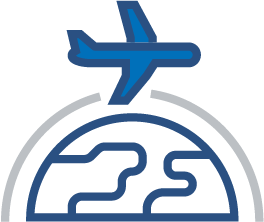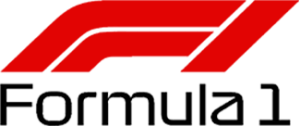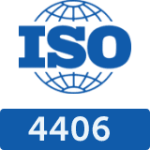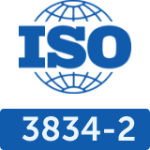
DSM makes major savings on pallet repair costs with KOOI Pallet Bumper. Simple idea; enormous effect
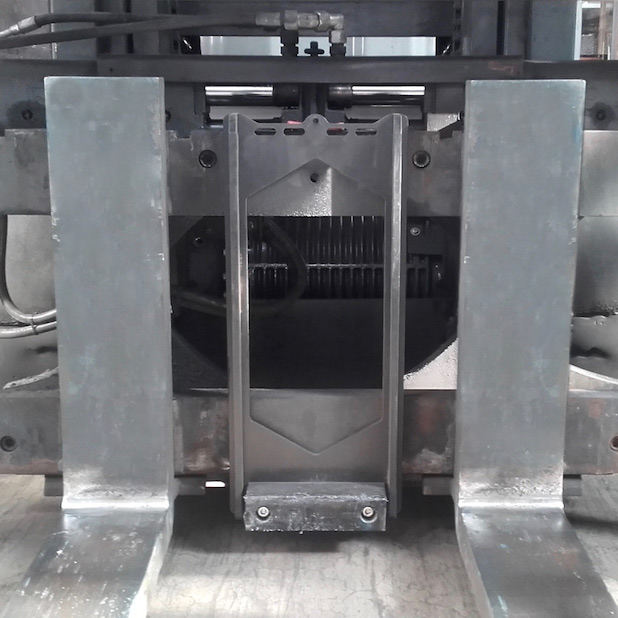
Educational trial deployment
Bert Arends found the solution to this long-running problem from Klaas Schepers, Director of PalRoRo, which is marketing a plastic pallet bumper in the Netherlands. This PVC unit is applied to the carriage plate to hold the pallet slightly away from the heel of the fork, do that the fork back does not touch the lead board. During an initial trial deployment, the advantages and disadvantages of the plastic pallet bumper were exposed. “It’s a good system, but just a little too one-sided as regards its size and possibilities”, Bert Arends continues. “So Klaas looked for an improvement and developed his own pallet bumper. This gives even better protection and makes the product more widely usable.”
The Pallet Bumper consists of a solid steel frame that matches the size of the forklift truck’s carriage plate. This means they fit on all commonly used carriage plate types, normally from 2A to 3B. The frame incorporates at least one and sometimes two blocks of synthetic material. The size of the block can be adjusted to the situation it is used in, which means the bumper can offer protection for various pallet types with a variety of top boards and spacer blocks, and loads which may or may not overhang.

Spectacular savings
Arends, together with Supply & Packaging Coordinator John Kuiper, submitted a Management of Change (MOC) application to the company’s management for the improved pallet bumper. In that way, DSM Engineering Plastics took a concrete step towards resolving this troublesome problem. DSM Engineering has now been using the KOOI Pallet Bumper (and some Plastic Pallet Bumpers) for a year, and the results are spectacular. During his safety tours, Bert Arends rarely encounters any more damaged pallets and notes that the repair costs have fallen almost to zero. “We used to spend over € 37,000 per year on pallet repair, and our investment in the Pallet Bumpers paid for itself within a few months”, he calculates. “And that’s not all. There is less rubbish in the building, and much less chance of damage to tyres and other forklift truck parts from splinters and loose boards. The chance of product contamination and damage to packaging has also been virtually eliminated. When you take these costs into account, the total saving soon comes to a factor of 2.”
The Pallet Bumper also has wide acceptance among the forklift truck drivers because they, too, are experiencing the advantages of the tool. They are hardly ever taken to task any more for damaging pallets. It is no surprise, therefore, that all the fitted units are still properly in place. Bert Arends expects to easily get the minimum 5 years of life out of each Pallet Bumper.
Meijer Handling Solutions introduces Pallet Bumper to market
Meijer Handling Solutions BV of Sint Jacobiparochie has taken over the production, marketing and sale of the Pallet Bumper from its spiritual father, Klaas Schepers. The product fits in seamlessly with the range of products marketed by Meijer, such as telescopic forks and the award-winning RollerForks. Various types of KOOI Pallet Bumpers are available for different FEM carriage plate sizes, and for pallets with and without overhang.
By fitting the KOOI Pallet Bumper to 24 forklift trucks, DSM Engineering structurally tackles the problem of smashed pallets. The bumper prevents the curve in the fork’s back pressing against the lead board of the pallet and breaking it. The saving in pallet repairs is so big that the investment pays for itself within three months. And this does not even take into account the secondary benefits.
At the EMMTEC business park in Emmen, DSM Engineering Plastics has three factories; one of them produces granular polyesters for a broad range of applications. The grains are subsequently processed in a compound factory. The third factory produces polyamide based on caprolactam as its raw material. The three divisions use forklift trucks for internal transport, predominantly at the compound factory. There are numerous handling actions between the delivery of the raw material and dispatch”, says Bert Arends of the Safety, Health & Environment (SHE) department. “We pick up the internally circulating pallets several times, and that doesn’t do any good to the quality of the load-bearer.”
Damage, destruction and pollution
While doing a safety tour of the site, Arends was struck by the number of damaged pallets at Compound. Despite lowering the maximum driving speed for forklift trucks, the forks often hit the pallets so hard that the lead board o the upper pallet deck was damaged. The board cracked or broke, leaving splinters or sometimes even entire pallet elements on the ground. Such damage reduced the pallet’s load-bearing capacity and could even result in damage to the goods. “Our bulk containers always bulge a little when they are on the pallet, and then you touch them with the fork back”, says Arends as he points to one of the units. “You only have to have the mast leaning forward a bit when picking up a pallet to pierce the top of the package and damage it. Of course, you don’t want that any more than we want splinters in the product when we rotate pallets to empty the packaging during the production process. For that reason, we had all the damaged pallets repaired, and even had to replace the packaging regularly.”

































